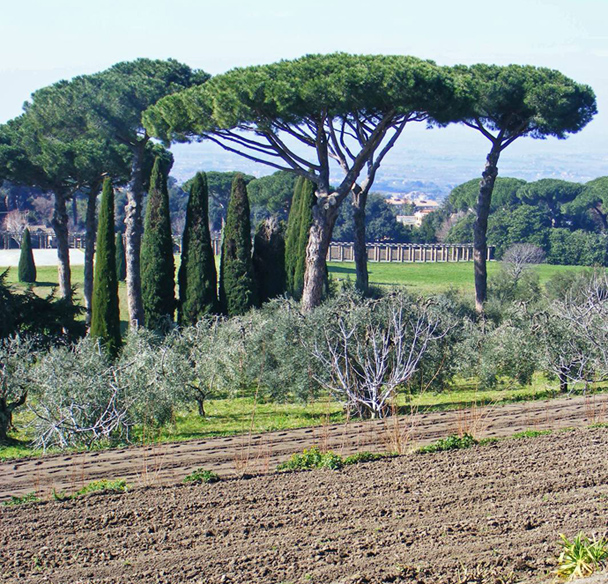Every morning in the town of Castel Gandolfo, a van pulls out of stately gates in a high wall, heads down the hill, and joins the snarl of traffic snaking its way north toward Rome. It’s part of a ritual observed since the 1930s, when Pope Pius XI oversaw the creation of a model farm at the papal villa in this town about 15 miles from the capital, overlooking Lake Albano. Today, as then, the van carries freshly laid eggs, milk from the pontiff’s cows, produce from the vegetable garden and orchard, honey from the hives, extra-virgin olive oil, and plump rounds of caciotta from the villa’s dairy to Vatican City, headquarters of the Catholic Church.
Behind a wide polished desk, with photos of popes past and present peering down at him from the walls, Saverio Petrillo—director of the villa here, a papal summer residence for most of the past four centuries—brushes aside speculation as to whether the pope waits for the day’s delivery before he sits down to breakfast. “But the farm’s produce certainly goes directly to the papal household in the Vatican,” he says, referring to Pope Benedict XVI and the large staff, lay and ecclesiastic, who ensure the smooth running of pontifical affairs. “And the rest goes to the annona [the Vatican supermarket], where employees of the Holy See can purchase it.”
The Castel Gandolfo farm, Petrillo explains, was Pope Pius’ symbolic outreach to the rural world. Nowadays, Petrillo continues, “we think of it as a rustic garden, with no clear break between the villa’s formal gardens and the farm. Look out here, for example,” he says, with a sweep of his arm toward the window, where the dense palette of greens ranges from dark cedars to the pale gray of ancient gnarled olives.
The steps linking the long, narrow terraces of the vegetable garden are dotted with huge terra-cotta urns, and chickens are housed in rows of little houses complete with tiled scenes of poultry life above their doors. Yet the atmosphere here is more efficiency and productivity than symbolic play-farm. Giuseppe Bellapadrona, farm and garden manager, lets slip, with a note of pride, that the enterprise’s annual production is valued at €250,000 ($330,000)—and makes a significant contribution to the papal residence’s running costs.
From the long series of greenhouses at the top of the sloping property to the modern mechanized cowshed at the bottom, the papal farm on a warm day in early March is bustling with activity. There are teams pruning olive trees, while others mend damage to buildings and fences caused by branches felled in February’s unusually heavy snow. In the vegetable garden, the earth is being turned over, ready for spring planting. In the greenhouses, workers are tending to potted plants brought here from the Vatican—“to recover from the stress of Rome,” says Bellapadrona—and lifting and dividing the Strelitzia reginae plants that provide dramatic bird-of-paradise blooms for Vatican flower arrangements.
Also here are tiny herb seedlings, which will be planted in the vegetable garden come spring. “Of course, we sow our own carrots and all those crops that go straight into the ground,” Bellapadrona explains. “But we buy other seedlings—zucchini, tomatoes, bell peppers, that kind of thing—from a local nursery. It’s just not worth our while sowing them ourselves.” The farm is not strictly organic, but “natural,” as Bellapadrona puts it: “We use copper sulfate to fight fungal diseases. And of course, the manure from our animals goes back into the soil. And if, for example, we have a plot of green beans with a bad attack of greenfly and it’s early in the season, we’ll dig up the plants, burn them, and start again in a different part of the garden. But if we don’t have time to do that, we will use chemical pesticides. Of course, we’re very careful about spraying well before harvest time: We respect all the instructions.”
The property at Castel Gandolfo is the pontiff’s private retreat, and it’s a rare privilege to be allowed inside. Employees here—30 or so, on the farm and in the gardens—are cagey about giving away anything about their boss. “But popes do like going down to see the cows,” Petrillo grudgingly admits.



 Pinterest
Pinterest


